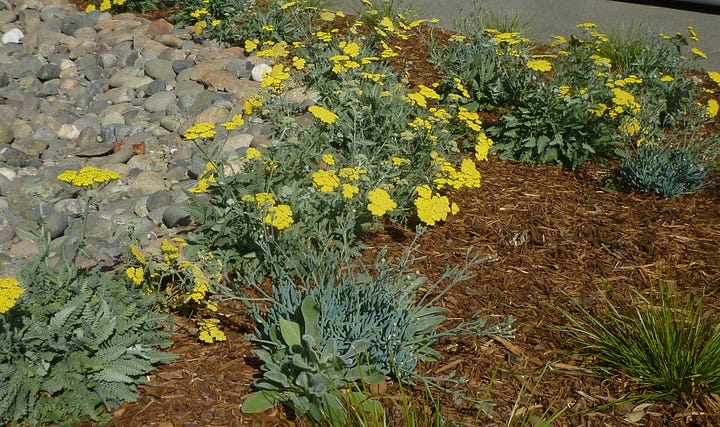Green Wednesday: Building Innovations and Rainwater Conservation Gardening
By Yvonne Rasmussen, UC Master Gardeners of Napa County / By Chris Benz, Environmental Contributor
Every Wednesday Napa Valley Features includes posts from environmental voices and the UC Master Gardeners of Napa County, who share research-based horticultural advice. Together, these contributors provide valuable insights into sustainable gardening practices and climate-related topics relevant to our region.
"Green Innovation in Home Construction" by Chris Benz, Environmental Contributor: This article explores the work of Beth Farley and her company, GRID Design Build, which focuses on environmentally sustainable and regenerative home construction, including projects that emphasize energy efficiency, renewable energy use and low-carbon materials.
"Plant a Garden to Save Precious Water" by Yvonne Rasmussen, U.C. Master Gardeners of Napa County: This article provides guidance on creating rain gardens to conserve water by capturing rainfall in soil, detailing plant selection and placement strategies for efficient water retention in Napa Valley's climate.Napa Valley Features is a reader-supported publication. To receive new posts and support our work, consider becoming a free or paid subscriber.
Plant a Garden to Save Precious Water
By Yvonne Rasmussen
NAPA VALLEY, Calif. — When we get rain in Napa Valley, it typically comes largely between December and February. This year we did get a tiny bit of rain in October, and hopefully we’ll get more this winter. No matter how much we get, we want to keep it here to feed our gardens, rivers and aquifers.
There are many ways to capture and store rainwater, but likely the best and easiest place is in the soil. To help move water into the soil, we need to slow it down and spread it so it has time to sink in. You can do this in several ways, including with plants, wattles or terraces on slopes, swales or in rain-capture gardens. I have been intrigued by the idea of a rain garden for several years and plan to attempt an installation soon.
The Napa County Master Gardeners and University of California have resources on this topic. We also partner with the Napa Resource Conservation District and the City of Napa Water Department on informational programs and garden tours so you can see examples of rain gardens. This University of California publication on Coastal California Rain Gardens guides you through creating your own rain garden with construction details and plant suggestions.
You want the rain to sink in within a couple of days to avoid attracting mosquitoes… Have fun, add some interest to your landscape and conserve water at the same time.
Be cautious when looking online for rain-garden information. Many plant lists are written for other locations and aren’t suitable for our Napa Valley climate, but California native plants can work well. If carefully chosen, they will need little care as they are adapted to our climate and rain patterns.
Consider carefully where to place your rain garden. Do not locate it over a septic field or in an area that stays soggy in winter. It needs to be in full to partial sun and away from large tree roots. You want the area to capture water but to drain fairly quickly. The idea is to get the water to seep into the ground and not create a pond that could harbor mosquitoes.


A rain garden only needs to be a few feet deep and wide. You can decide the best width and depth based on how much water you are getting and your soil type. The latter will determine how quickly water soaks in — faster in sandy soil, more slowly in clay. That being the case, for sandy soils the garden can be narrower than if it contains clay.
A passive rain garden can be any size. You want the rain to sink in within a couple of days to avoid attracting mosquitoes. The Coastal California Rain Gardens guide has calculations to help you figure dimensions.
Lining the rain-garden area with rocks will help stabilize the soil. Add a few carefully placed larger boulders for aesthetics and to make the area look like a dry stream during the off season.
Choose your plants carefully. Plants on the bottom need to tolerate being flooded during the rainy season and dry in summer. Using low-water plants around the top will keep it easy to maintain. Some good plants for the bottom are sedges, rushes, equisetum and Douglas iris — the same plants you might see in seasonal creeks. For the mid-slope, choose plants that will help retain the soil with netted roots. Also give preference to plants that don’t need much summer water, such as sedges, rushes, Juncus, Woods’ rose, salt grass and yerba buena.
For planting around the top edge, look for drought-tolerant plants: sages such as pitcher sage or salvia clevelandii, California fuchsia, yarrow, ceanothus and California polypody fern. Some of these plants will go dormant during the dry season but will come back from roots when they get water.
You can find good information on California native plants at CalScape.org. Take note of their height and width at maturity so you get the look you want. This site also has information about plants that attract bees, butterflies, birds and other pollinators so you can consider them as you plant your rain garden.
You can see some examples of rain-capture gardens around the town of Napa. Many new buildings have them to filter runoff from parking lots and other hardscapes.
Your rain garden can be as simple as a low spot lined with rocks or as ambitious as an area that looks in summer like a dry river bed. Have fun, add some interest to your landscape and conserve water at the same time.
Library Talk: Join UC Master Gardeners of Napa County for a talk on “How to Improve Water Retention in Our Landscapes,” on Thursday, Nov. 7, at 7 p.m. via Zoom. Learn some water catchment/retention approaches that you can use in your own yard to “Slow It, Spread It and Sink It.” Register to receive the Zoom link.
Help Desk: The Master Gardener Help Desk is available to answer your garden questions on Mondays and Fridays from 10 a.m. until 1 p.m. at the University of California Cooperative Extension Office, 1710 Soscol Ave., Suite 4, Napa. Or send your questions to mastergardeners@countyofnapa.org. Include your name, address, phone number and a brief description. For best results attach a photo.
If today's story captured your interest, explore these related articles:
Transform Your Garden — Embrace Low-Maintenance Native Plants
Weekender Encore: Nature’s Sweet Treasure — The Blackberries of Napa Valley
Yvonne Rasmussen is a UC Master Gardener of Napa County.
Green Innovation in Home Construction
by Chris Benz
NAPA VALLEY, Calif. — Beth Farley knew she wanted to be an architect in high school as the perfect way to combine her math abilities with her love of art and good design. Today she is the CEO and chief architect of GRID Design Build, which she owns with partner Lisa Massaro. The company offers a holistic approach to housing that incorporates climate and community benefits.
GRID evolved from Healthy Buildings, the Napa firm founded by Massaro’s late husband, Bob, a 2022 Napa Climate Champion and City of Napa Planning Commissioner.
“Lisa, the company CFO, and I wanted to create a women-owned business that provided development, architecture and construction services,” Farley said. “About 2½ years ago we started the paperwork to transition, and I got my general contractor’s license. Bob’s passing was a huge loss – he played a big role in our company and the community.”
Net zero energy is the goal. We start with a tight building envelope with better-than-required insulation and include solar panels, all-electric appliances and energy-saving lighting.
GRID stands for Green Regenerative Innovative Developments, which captures how Farley approaches project design.
“A green approach takes the site environment into account,” she said. “How can the building have the least impact and bring the most benefit? How will solar fit on the roof? How will rainwater run off? What landscaping features will promote soil health, capture carbon and support local ecosystems? For multihome development, how will the neighborhood community be enhanced?”
Regenerative design aims to improve — not just sustain — the building’s environmental footprint.
“Net zero energy is the goal,” Farley said. “We start with a tight building envelope with better-than-required insulation and include solar panels, all-electric appliances and energy-saving lighting. This makes a home much more energy-efficient and economical to operate in the long term.”
It also results in lower emissions of pollutants that cause global warming. The 2019 Napa County Greenhouse Gas Inventory reported that emissions from the building energy sector accounted for almost 23% of total emissions. GHG emissions from natural-gas use accounted for three-quarters of total emissions from this sector. Replacing natural gas with renewable energy from solar panels greatly reduces a building’s carbon footprint.
Among its current projects, GRID is on the team slated to build 10 mini-townhomes in Sebastopol, each less than 600 square feet.
“The idea is to create a housing type for a single professional or a young couple that can’t afford a larger home or for an older single or couple that wants to downsize and is done with yardwork,” she said. “All the units front onto a community space with their kitchen sink windows and front porch areas. Each has a tiny backyard, enough for a planter garden.”
A second project, Harvest Village, will construct nine single-family homes in the city of Napa, each with an attached ADU (accessory dwelling unit). By making the ADU part of the building envelope, construction costs can be kept down. Separated by a door, it can be used as separate quarters for adult children, aging parents or tenants, or as an additional part of the home.
Farley’s travels, her experience with smaller living spaces, and her dedication to sustainability have led her to explore new styles of housing and new building materials.
“We’re always looking to push the envelope for a better, lower-carbon footprint building,” she said. “We incorporate greywater systems that collect bathroom sink, shower and tub water to irrigate yard plantings. I’m interested in trying out new building materials and am looking forward to working with ‘low-carbon concrete,’ which is produced with a lower carbon footprint.”
She sees a lot of potential within the city of Napa for denser housing on unused or underused lots, pointing out that the lot in Sebastopol for 10 mini-townhomes is less than half an acre.
“We can take these smaller infill lots, where there may be one run-down home, and put three homes or even more mini-townhomes on them,” she said. “I think the city is open to increasing density to create more housing that is affordable.”
Action you can take: Learn more about rebates and financing for energy-efficient retrofits here.
If today's story captured your interest, explore these related articles:
Napa's Path to Sustainability: Weaving Local Plans Into One Resilient Future
Birdwatching in Napa County Reveals Avian Wonders and Conservation Champions
Calistoga's Old Faithful Geyser: From Tourist Trap to Natural Wonder
Green Wednesday: Fall Gardening Fun and Youth Climate Advocacy
Under the Hood: Climate Change's Growing Impact on Napa Valley
Pruning and Climate Adaptation Tips for Home Vineyards in Napa Valley
Black Sears Family Donates Land to Help Create Wildlife Corridor
Chris Benz is a retired winemaker and co-founder of Napa Climate NOW! a local nonprofit citizens’ group advocating for smart climate solutions based on the latest climate science, part of 350 Bay Area.








I have swales and they work well. Good job!!!!